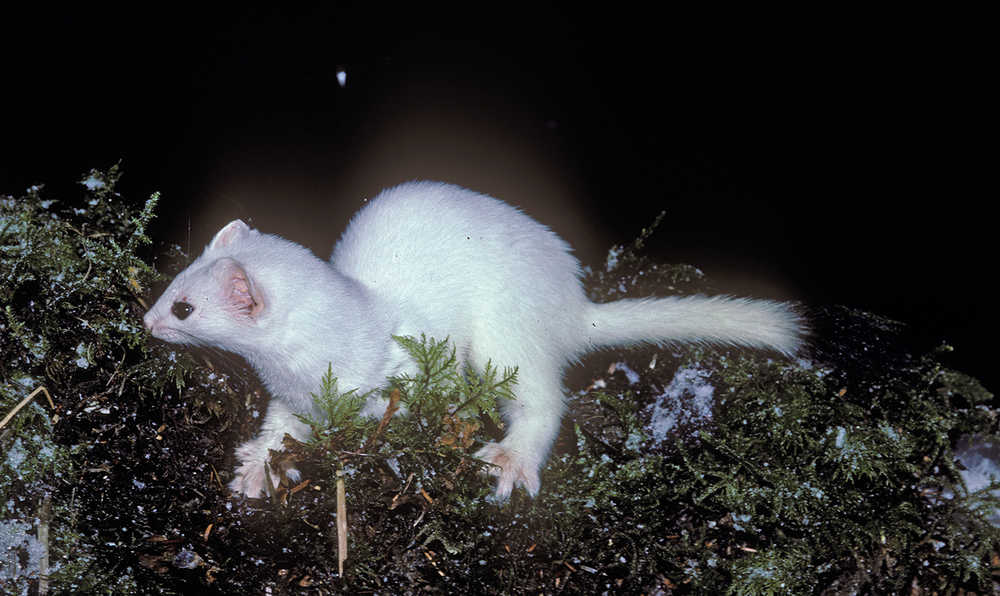A bright, cold day—just right for a little exploration. A friend and I headed for Hilda meadows: up Trickster (not groomed), onto the groomed upper cross-country ski loop, over the snow bridge on the creek, and through some brush. We found a tiny patch of sun just in time for ‘elevenses’. Tiny indeed, and short-lived; the sun soon rolled around behind the ridge that is the Douglas Island backbone, and all was shady again.
Our perambulations revealed a wealth of animal tracks. The snow was a bit crunchy but not too hard for good tracking. Peripatetic porcupines had trekked long distances over meadows and into the woods. Most of their tracks were quite small, suggesting that these little fellows had been born just last spring. We noticed the one of them toed out more than others and so was individually recognizable.
There were a few squirrel and hare tracks, but not as many as some other times, a possible marten track, one ptarmigan had snooped around some blueberry bushes, and several weasel tracks. Short-tailed weasels or ermine had left evidence of their passing across the open snow, down under logs and brush, then back out again. Then, luckily, we chanced to see, out of the corners of our eyes, a moving blur, which briefly vanished under a stump and peeked out as a pair of beady black eyes on a small white face. The beastie itself! It scooted over to a log and peeked out again. Watching carefully, it apparently decided we were not much of a threat and bounded leisurely off, flaunting its black tail-tip. Ermine are more often tracked than seen, in my experience, so this was great fun. We were interested to observe that its fur was, in fact, not white as snow, but rather yellowish, so it stood out against a truly white background. Had the fur been stained by tannins (which turn many of our streams brownish) in wet moss?
We found a few examples of dead wood with frosty ‘fur,’ a less spectacular version of what I reported a week or two ago. On that previous walkabout, there were wonderful sheets of silk-like strands nicely waved; any professional hair-dresser could have been proud of the result. I have recently learned that this phenomenon is actually called ‘hair ice’! The hairs are extremely fine: only about a one-hundredth of a millimeter thick, but they can grow to many centimeters in length. The process is roughly like this: As the water at the surface of the decaying wood freezes, more water is pulled from the surrounding wood, and it pushes out threads of ice from pores on the wood surface. The geometry of the openings of the pores in the wood influences the shape and direction of the hairs.
Somehow, a wood-decay fungus is directly involved, as was suspected a hundred years ago by Alfred Wegener (of continental-drift fame). Experimental elimination of the fungus by application of fungicide or heat totally prevents the formation of hair ice. Recent studies in Europe revealed that one particular winter-active fungus (Exidiopsis effusa) is consistently involved in the development of hair ice on a variety of broad-leaved trees. Filaments (technically, hyphae) of the fungus grow along the fluid-transporting vessels and rays of the wood. The fungus digests lignin, which makes wood hard, and also takes up tannins from the decaying wood. So far, so good. But exactly what the fungus does in the formation of hair ice is still a mystery. The decomposed lignin and tannins may provide a ‘crystallization nucleus’ that starts the formation of ice at the wood surface, or they might prevent the tiny ice crystals of the hair ice from recrystallizing into large crystals. And somehow the fungus might help determine the shape of the hair ice. Much remains to be learned!
I have not yet learned if that particular fungus occurs in Alaska, but we do have related species. And we certainly have hair ice. So another chapter of the story is waiting to be written.
Mary F. Willson is a retired professor of ecology.

